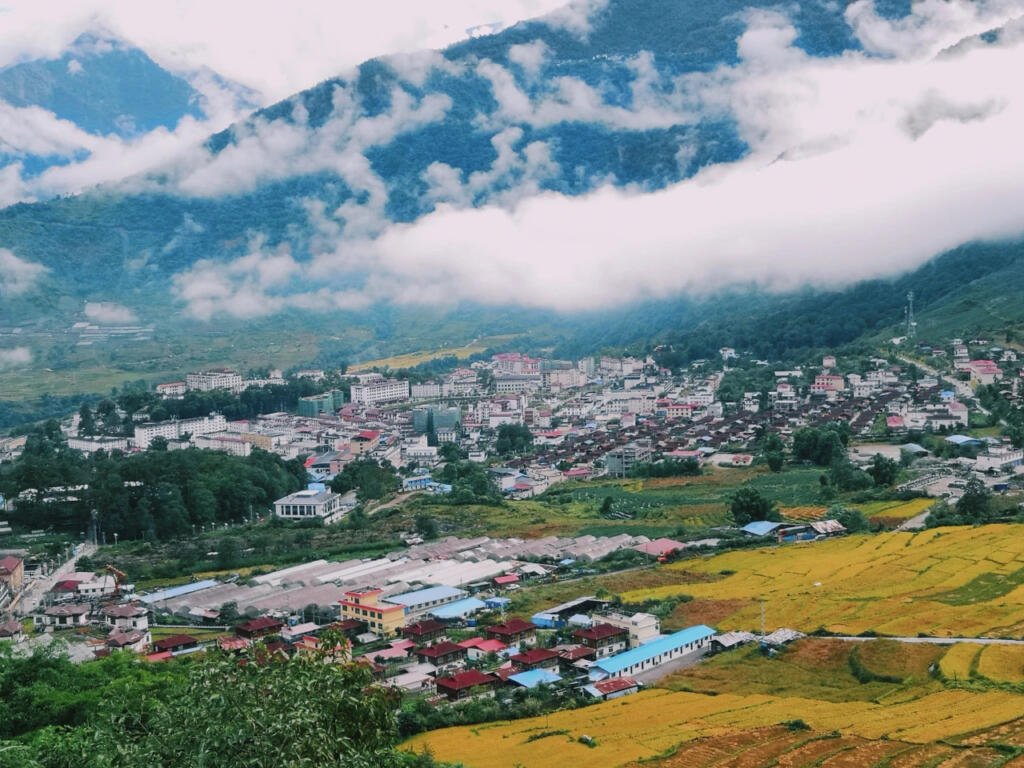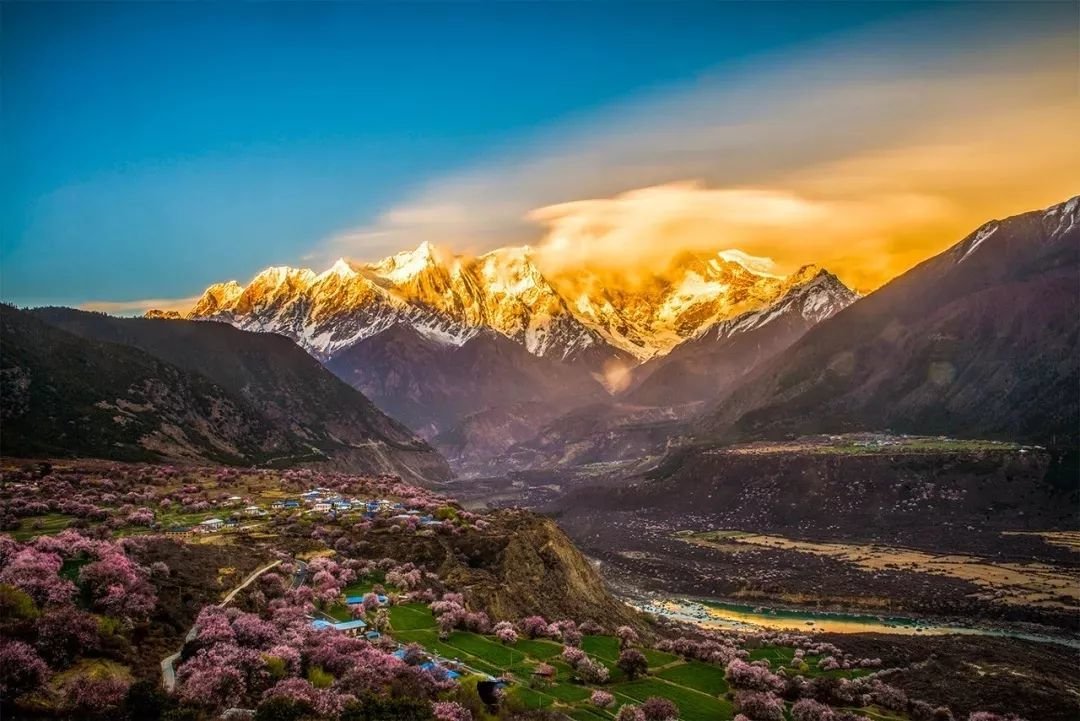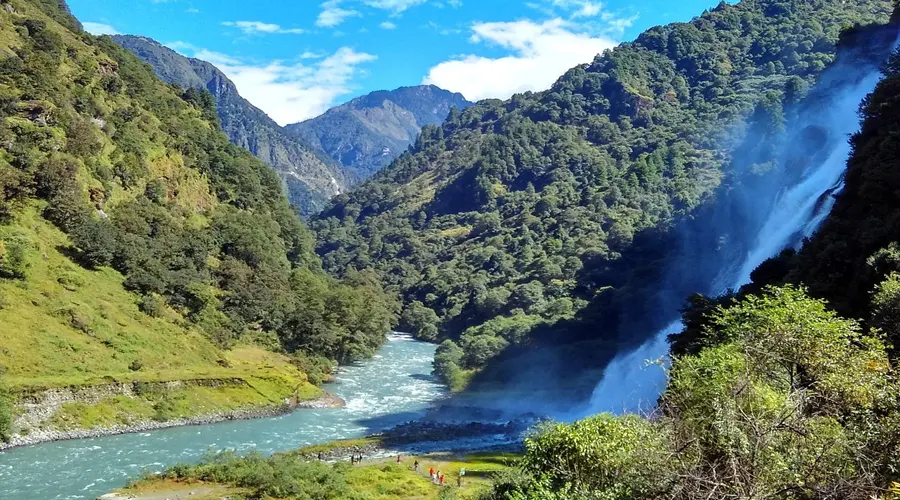Mêdog County, (མེ་ཏོག་རྫོང་།) with its evocative name translating to “flower” in Tibetan and its historical nickname Pemako (པདྨ་བཀོད་)meaning “hidden lotus,” holds a special allure. Nestled in the southeastern corner of Tibet, its geographical setting is both dramatic and enchanting. The lower reaches of the Yarlung Tsangpo River, the eastern section of the Himalayas, and the southern slopes of the Gangdise range cradle the county.
The proximity to various significant geographical and administrative entities defines Mêdog’s borders. To the east, it shares borders with Zayü County, emphasizing the interconnectedness within the region. To the south, India neighbors it, marking an international boundary that also underscores the diverse cultural and ecological exchanges between the two regions. The areas in the southern Tibet region adjacent to India are of particular interest for their unique blend of cultural and natural heritage.
To the west, Mêdog is bordered by Milin, Lhünzê, and Cuona counties, while to the north, it is neighbored by Bomê County and Bayi District. These adjacent areas contribute to the rich tapestry of cultural and ecological diversity that characterizes Mêdog and its surroundings.
Historical Snapshot of Nyingchi Medog County
This area, originally inhabited by the Lhoba people during prehistoric times, saw the Mênba people start migrating in by the mid-17th century. In 1881, the Pomi king, Gyalam Wood, established a regime in Mêdog, appointing a Mênba individual, Nono La, as the first ruler. Post 1927-1931, after the Gadê government defeated the Pomi king, Sera, Tengdü, and Songzong monasteries divided Mêdog among themselves until the peaceful liberation of Tibet.
In July 1959, the founding of Mêdog County occurred under the Tagong region, later coming under Lhasa’s governance in 1964, and eventually incorporating into the Nyingchi region (now city), with Mêdog Town hosting the county government. As of 2022, it administers one town, seven townships (including one Lhoba ethnic township), 46 administrative villages, and 60 natural villages, covering an area of 31,450 square kilometers. As of November 1, 2020, the permanent population stands at 14,889 people. By February 6, 2019, Mêdog left the list of impoverished counties and earned the title of one of China’s top 100 counties for summer leisure in 2020.
Administrative divisions
Mêdog County comprises 1 towns, 6 townships and 1 ethnic township:
| Name | Chinese | Hanyu Pinyin | Tibetan | |
|---|---|---|---|---|
| Town | ||||
| Metok Town | 墨脱镇 | Mòtuō zhèn | མེ་ཏོག་གྲོང་རྡལ། | |
| Townships | ||||
| Jarasa Township | 加热萨乡 | Jiārèsà xiāng | བྱ་ར་ས་ཤང་། | |
| Ganden Township | 甘登乡 | Gāndēng xiāng | དགའ་ལྡན་ཤང་། | |
| Bangxing Township | 帮辛乡 | Bāngxīn xiāng | སྤང་ཞིང་ཤང་། | |
| Gutang Township | 格当乡 | Gédāng xiāng | དགུ་ཐང་ཤང་། | |
| Dezhing Township | 德兴乡 | Déxīng xiāng | བདེ་ཞིང་ཤང་། | |
| Drepung Township | 背崩乡 | Bèibēng xiāng | འབྲས་སྤུངས་ཤང་། | |
| Ethnic township | ||||
| Takmo Lhoba Ethnic Township | 达木珞巴族乡 | Dámù Luòbāzú xiāng | སྟག་མོ་ལྷོ་པ་མི་རིགས་ཤང་། | |
| * includes areas claimed but currently under control of the Indian state of Arunachal Pradesh. | ||||

Geography and Climate of Nyingchi Medog County
Mêdog lies between 27.6 to 29.9 degrees north latitude and 93.7 to 96.1 degrees east longitude. Mêdog enjoys a subtropical humid climate on the eastern side of the Himalayas, with an average elevation of 1,200 meters. The terrain slopes from north to south, surrounded by mountains, making it rugged and forest-covered. The Yarlung Tsangpo River carves through the region from the foot of the Namcha Barwa peak, creating the world’s deepest and longest canyon.
The highest areas lie at the southern feet of Namcha Barwa and Gyala Peri peaks, reaching elevations of 4,000-5,000 meters, while the lowest point is Baxika at the river’s exit, at 154 meters above sea level. Notable mountains include the Eastern Himalayas, Gangdise, and several others, with Namcha Barwa peak standing tall at 7,787 meters.
The climate is perpetually spring-like, marked by abundant rainfall, mild winters, and cool summers. Mêdog experiences frequent natural disasters such as insect plagues, floods, landslides, mudslides, and earthquakes, with an average annual precipitation of about 2,000 mm, less than 2,000 hours of sunlight, a frost-free period of 340 days, and an average annual temperature of 12°C.
Mêdog’s Signature Products: A Treasure Trove of Natural Remedies
Nestled in the southeastern part of the Tibet Autonomous Region, Mêdog County is not just a picturesque landscape but also a rich repository of agricultural abundance and traditional Tibetan medicine. Known for its diverse flora and fauna, Mêdog’s unique geographical conditions foster the growth of several medicinal herbs and plants, contributing to its reputation as a hub for natural remedies and specialty products.
Exploring Mêdog’s Natural Pharmacy
Holly Fern (Leptorum japonicum):
Often referred to as “monkey ginger” or “Pajang Reja” in Tibetan, this perennial herb stands 15-35 cm tall. Its rhizome is thick and fleshy, covered with brown scales. Holly Fern contains hesperidin and glucose, and its rhizome, when brewed, can inhibit the growth of staphylococcus, prevent hyperlipidemia, and reduce the formation of atherosclerotic plaques. In traditional Tibetan medicine, practitioners use it to clear heat, reduce fever, relieve pain, strengthen the kidneys, and promote childbirth. It’s also rich in starch, making it a potential ingredient for brewing.
Dendrobium (Dendrobium nobile):
Also known as “Jin Chai Shi Hu” or “Buxieze” in Tibetan, this evergreen herb thrives on tree trunks, with stems that are upright, yellow-green, and bear distinctive nodes and grooves. It blooms in summer with translucent white flowers, slightly tinged with purple-red. Dendrobium contains a variety of alkaloids and mucilage, making it valuable in traditional Tibetan medicine for nourishing stomach yang, clearing heat, producing fluids, eliminating irritability, and treating chronic gastritis, hyperchlorhydria, tuberculosis, and other conditions.
Torreya grandis (Chinese nutmeg yew):
An important anti-cancer plant, the Chinese nutmeg yew is a small evergreen tree reaching up to 20 meters. The bark is brown or red-brown, and the seeds are slightly flat, with an ovate-elliptical shape. Its branches, leaves, seeds, and bark contain multiple anti-cancer alkaloids, offering effective treatment for acute and chronic myelocytic leukemia and inhibiting the growth of certain cancer cells. It shows promising results in treating lung cancer, stomach cancer, maxillary sinus cancer, esophageal cancer, lymphosarcoma, leiomyoma of the uterus, choriocarcinoma, Hodgkin’s disease, and various malignancies.
Tips for Exploring Mêdog’s Specialties:
- Holly Fern and Dendrobium are not only medicinal but also potential ingredients for traditional brewing practices.
- The Chinese nutmeg yew’s anti-cancer properties make it a significant contribution to medical research and treatment, offering hope for various cancer patients.
- Mêdog County, with its rich resources and unique climate, continues to be a vital source of traditional Tibetan medicine and natural remedies, preserving the heritage and promoting the well-being of its people and beyond.
Discovering the Cultural Landscapes of Mêdog: A Journey Through Nature and Tradition
Mêdog County, nestled in the subtropical humid climate zone of the Tibet Autonomous Region, presents a diverse range of landscapes that span from alpine cold zones to tropical rainforests. With an elevation difference of several thousand meters, Mêdog offers a rich tapestry of natural beauty across its 33 main attractions. These include 8 natural scenic spots, 17 grand canyon views, 5 tropical plant and pastoral sceneries, and 3 trekking and tropical rainforest experiences.
Exploring Mêdog’s Road to Nature
The Mêdog Highway, stretching 117.2 kilometers, is dotted with various tourism projects related to forestry and agriculture, as well as specialized scientific research tours. Tourists can immerse themselves in the “Agro-tourism” experience, visiting the homes of the Monpa and Lhoba peoples to witness their traditional slash-and-burn agriculture, hunting lifestyles, and the genuine warmth of their culture and customs.
Popular Local fruits in Nyingchi Medog county
Bananas of Mêdog:
Mêdog gains renown for its bananas from the Musaceae family. This perennial herbaceous plant forms an upright and soft “pseudo-stem” through leaf sheaths and produces fruits that are aromatic, sweet, and nutritionally rich. Researchers have proven bananas to alleviate dysentery and regulate gastrointestinal functions, neutralizing acidity and benefiting individuals with stomach ulcers. Beyond fresh consumption, people can process bananas into canned foods, and use the pseudo-stem for feed, fiber, and paper-making materials. the plant itself is also a beautiful ornamental.
Citrus Fruits of Mêdog:
Celebrated for its citrus production, Mêdog grows various citrus fruits, known for their refreshing taste and medicinal properties. Citrus, encompassing both “tangerines” and “oranges,” thrives in Mêdog’s warm climate. People enjoy the fruits fresh or process them into canned goods, juices, and wines, while they use the leaves, peels, seeds, and pith as valuable traditional medicines. They can make the flowers into tea or extract them for essential oils, highlighting the multifaceted uses of citrus in Mêdog.
Lemons of Mêdog:
The lemon trees of Mêdog, flourishing in its unique ecosystem, produce large fruits that are a sensory delight. Traditionally, lemons were a prized gift among the Monpa people for their healing properties, especially remarkable during times when modern medicines were scarce. Lemons are known for their ability to quench thirst, moisturize the lungs, clear the heart, reduce phlegm, cool down fevers, and detoxify the body. Lemons from Mêdog not only offer aesthetic and gustatory pleasure but also possess significant medicinal value, promising potential economic benefits for the local community.
Mêdog County, with its abundant natural resources and cultural heritage, invites visitors to explore its scenic landscapes and partake in the rich traditions and lifestyles of its indigenous peoples. From the luscious bananas to the tangy citrus and lemons, Mêdog presents an enchanting world where nature and culture intertwine, offering a unique experience that captivates the heart and soul of every traveler.
Exploring Mêdog: Tibet’s Hidden Gem Now Accessible to Adventurers
Mêdog County, once the only county in China unreachable by road, celebrated the opening of its connecting highway on October 31, 2013. An investment of 1.599 billion yuan constructed this road, spanning 117.278 kilometers and designed to Grade 4 highway standards, which makes the previously elusive region accessible for 8-10 months a year. Prior to this, only the most intrepid of explorers could recount tales from this mystical area. With a commitment to preserving its pristine natural beauty, Mêdog welcomes future explorers to enjoy trekking, self-driving tours, rock climbing, and zip-lining among other adventurous activities.
Following the highway’s completion, Mêdog has strategically planned its tourism development around “one core, two hearts, three belts, and four zones.” This includes a central tourism service in Mêdog Town, two tourist service centers (at 80K and Beibeng Village), three tourism development control belts (the Mêdog Highway – Duoxiong La tourism belt, the Canyon Three Villages tourism belt, and the Jinzhu Tsangpo tourism belt), and four sustainable tourism development areas (from Mêdog Town to Dexing and Beibeng Townships, Damu – Garong La, and the southern Mêdog resource area). The best time to venture into Mêdog by foot is from July to October each year.
The Paimo Highway, which fully opened on May 16, 2021, serves as the second major route into Mêdog County following the Linzhi Zhamo Highway. This 67.22-kilometer road, traversing the Duoxiong La snow mountain and running alongside the Duoxiong River through Hanmi and Tiger Mouth to reach Beibeng Township in Mêdog, reduces the travel distance from 346 kilometers to 180 kilometers and cuts the journey time to approximately 4 hours. This development is poised to boost tourism, commerce, and ethnic cultural industries along the route, thereby increasing the income and prosperity of local communities.
Travel Tips for Nyingchi Medog County:
Border Permit:
As Mêdog is a border county, visitors are required to obtain a border permit from public security departments. It’s advisable to apply at your place of residence or through a travel agency.
Transportation:
Post-road construction, taxis are available in Mêdog County, making local travel convenient with fixed rates for various destinations. The county has witnessed significant urban development with modern buildings, roads, plazas, and recreational facilities, marking the end of Mêdog’s history as a county without a city.
Self-driving Route:
Spanning approximately 164 kilometers, the self-driving tour starts from the Zhamo Highway, passing through scenic spots like the Garong La waterfall, Heavenly Lake, tunnels, the Swallow Ditch, Mêdog Waterfall Cluster, Monpa and Lhoba ethnic homes, and a vast array of flora and fauna, including the “living fossil” Wollemi pine. Alternatively, travelers can embark on a journey from Linzhi via the Paimo Highway.
Mêdog invites adventurers to explore its enchanting landscapes and rich cultural heritage, now more accessible than ever.
Exploring the Spiritual Heart of Mêdog: Its Monasteries
Mêdog County, nestled within Nyingchi City, Tibet, is home to several revered monasteries, each with its unique spiritual significance and historical background. These sacred places not only serve as centers for Buddhist practice and study but also stand as testament to the rich cultural tapestry of Mêdog. Here’s a glimpse into some of the most notable monasteries in Mêdog:
- Renqing Beng Monastery in Mêdog Town
- Zengqiu Monastery in Gala Township
- Gedang Monastery in Gedang Township
- Luobang Lakang Monastery and Maer Beng Monastery in Dexing Township
Visiting these monasteries in Mêdog offers a profound insight into Tibetan Buddhism and provides a unique opportunity to experience the spiritual heritage of Tibet. Each monastery, with its distinct character and history, invites visitors to explore the depth of Buddhist philosophy and the beauty of sacred Tibetan architecture.







